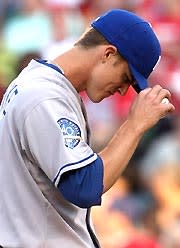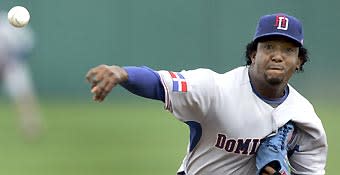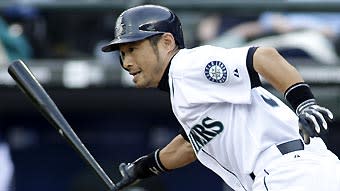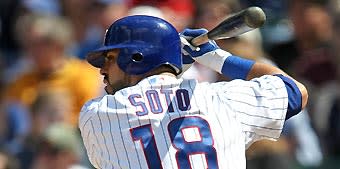Acknowledging anxiety made Greinke a torchbearer
Besides being baseball's best pitcher this spring, Kansas City's Zack Greinke(notes) has performed a huge service to the game, according to sports psychologist Harvey Dorfman. Because of Greinke, baseball players no longer have to hide the fact that they are prone to some of the same stress and anxiety issues that affect the rest of society.
That used to be baseball's ugly little secret, said Dorfman, who was hired by the Oakland Athletics in a groundbreaking move 25 years ago, later worked for the Florida Marlins and Tampa Bay Devil Rays (as they were known at the time) and for the last 10 years has worked as a sports psychology consultant for agent Scott Boras' large stable of clients.
"Greinke set the precedent,'' Dorfman said by phone Tuesday from his home in North Carolina. "And you know why? Typical baseball. Because he came back from his problems and kicked butt. It was no longer a dirty word.''

The Royals' Zack Greinke leads the league for starting pitchers with a 1.10 ERA.
(Stephen Dunn/Getty Images)
Greinke, who three years ago was diagnosed with depression and social anxiety disorder, underwent treatment and not only returned to pitching, which he was prepared to give up, but has reached the pinnacle of his profession. Greinke's success, Dorfman believes, has made it easier for other players to acknowledge their issues and seek help.
Already this spring, three players have been placed on the disabled list with mental health issues. In spring training, Detroit pitcher Dontrelle Willis(notes), who performed miserably last season and was pitching poorly in Tigers camp, went on the DL with what was described as anxiety disorder. Willis, placed under a doctor's care and receiving undisclosed treatment, returned to the club last month and has pitched well.
Then last week, just two days apart, Cardinals shortstop Khalil Greene(notes) and Reds outfielder Joey Votto(notes) also were placed on the DL, Greene on May 28 with what was described as a social anxiety disorder, Votto on May 30 with stress-related issues. Votto had been bothered by dizziness stemming from what the team had termed an ear infection, which is why many baseball people were caught by surprise by the latest development. Manager Dusty Baker said Votto was dealing with a personal issue.
Publicly acknowledging such issues in the past was unheard of in baseball.
"I think the reason guys didn't do it is because they kind of sloughed it off as nervousness, or overnervousness,'' said one former pitcher who asked that his name not be used. "We didn't realize it was more complicated than that.''
Dorfman said that when he was hired by then-general manager Sandy Alderson and the Athletics in 1984, the notion of a sports psychologist spooked a lot of players. It was only the rare exception who would acknowledge that an issue was more mental than physical. He cited Doug DeCinces as an example. In the late '70s, DeCinces was having difficulty dealing with the stress of replacing the legendary Brooks Robinson at third base in Baltimore and eventually went to see a psychiatrist, whom he has credited with helping to save his career.
"When I started, what I did was unheard of,'' Dorfman said. "And teams would hide from the public any [mental health] issues. They'd fudge, make up an injury. It was like, 'Do whatever you have to do, but don't tell anybody.' "
Over time, Dorfman, who used to change into uniform and circulate among players during batting practice, won their trust, and soon they were confiding in him.
"Tony Phillips came up to me and said, 'For two years I ran away from you because I had something to hide. [Eventually], I ran toward you,' " said Dorfman, referring to the former infielder who played on Oakland's 1989 world championship team. "I told him, 'Maybe if you had run to me sooner, it would have never gotten to that point.' "
It was critical symbolically, Dorfman said, that Greinke succeeded: "There would be great reluctance to put a guy on the DL with these issues if you thought they'd never perform again, that it would be like kissing them off. Greinke showed that that was wrong-headed. He showed that it was a disability at the time, but it was solvable.''
Last week, Greene publicly addressed his issues, saying that his continual anxiety about failing make him prone to outbursts, both physical and verbal, in front of teammates.
"It's difficult for me right now," Greene said. "It's difficult for me to manage that. I don't know how many people can relate to it. It's so strong. It's a very intense feeling and it's very unpleasant. It's not life threatening. I'm not putting myself at risk. But at the same time those responses are there automatically. I really have to concentrate to slow down, focus and stay in the game."
There is comfort, Dorfman said, in players knowing they are not alone: "A player needs to understand that he is not an isolated case. There is security in numbers, and they shouldn't be stigmatized because of it.
"And what people don't understand is what these guys go through to compete at this level.''


Pedro Martinez pitches for the Dominican Republic.
(AP Photo/Jeff Roberson)
Patient Pedro: Pedro Martinez(notes) continues to work out daily in the Dominican Republic, throwing and preparing for the eventuality of being signed by one of the many teams in need of a starting pitcher. Agent Fernando Cuza said Tuesday he is talking to a number of teams but there is no timetable. "He could make a decision tomorrow, and say let's get it over with, but he wants to make sure he goes to the right situation,'' Cuza said. "He's not in a hurry to jump at something, and then the perfect situation opens up a week later.''
Martinez would have been signed in spring training had he asked for less in guaranteed money than a reported $5 million. But Martinez is bent on re-establishing his market value with a strong second half for a contender, and reports out of his camp, and from scouts that have been to the Dominican, is that he is healthy and throwing easily. The guess here is that Martinez will sign in the next three weeks, giving him time to make two or three tune-up starts before the second half begins, and he'll prove to be a factor in the race. Last season, he was hurt and also impacted by the death of his father; he will be coming back physically and emotionally refreshed, which could make him a very dangerous pitcher.
"Pedro was still getting it to 91, 92 [mph] last season,'' one National League executive said. "He still has the command and feel to be successful, even if he has to pitch more like a Frank Tanana. Unless there is a lot of pain and discomfort in his shoulder, which would affect command, he can still win.''
Mannywood vs. Pierre Place: How much does the Dodgers staff like Juan Pierre(notes)? "Always the first guy here and the last to leave,'' said first base coach Mariano Duncan. "If they were all like Juan Pierre, you wouldn't need coaches,'' said bench coach Bob Schaefer. "Come by Dodger Stadium when we're home at 1:30,'' GM Ned Colletti said, "and you'll find him running from foul line to foul line.''
Pierre was framed as one of Colletti's biggest mistakes when he became a part-timer last season, in just the second year of the five-year, $44 million free-agent deal he got from the Dodgers. At the time they signed Pierre, after the 2006 season, the Dodgers were certain of only one everyday outfielder, Andre Ethier(notes), and he played little that previous September. The Dodgers took runs at Alfonso Soriano(notes) and Carlos Lee(notes) before signing Pierre, who also had a four-year, $40 million offer on the table from the Giants. Pierre hit .293 and stole 67 bases his first season, but the Dodgers needed more punch in their lineup, Pierre became a part-timer, and then became buried even deeper on the bench when the Dodgers traded at the deadline for Manny Ramirez(notes). But with Ramirez suspended 50 games, Pierre stepped into the breach and has played marvelous baseball. He is batting .388 with 22 runs, 18 RBIs and 10 steals during Ramirez's absence, which reached its midpoint Tuesday.
"Juan Pierre was never meant to be more than a complementary piece – he wasn't signed to be a middle-of-the-order guy,'' Colletti said. "He's consistent with what he does well, he's consistent with what he's short, but I never worry about his attitude, never worry about him being ready to play, never worry about him doing what he can to help us win a game.''
Add Mannywood: Setting the record straight – As numerous readers, including one from Kenai, Alaska, pointed out, in a column last weekend I botched the Dodgers' record before and after Ramirez was suspended. I was trying to make a tongue-in-cheek point that maybe as in the case of Alex Rodriguez(notes), teams would play better without Ramirez than with him, even though the sample size with the Dodgers was far too small to draw any conclusions. The humor didn't work, and neither did the premise. The Dodgers 15-10 without Manny after starting the season 21-8 with him. They averaged 5.6
runs a game with him, 5.4
without and hit 24
home runs with him, 13
without. I apologize for the mistake.

Mariners' Ichiro Suzuki sets a franchise hitting streak record at 26 on Tuesday after a leadoff single against Baltimore.
(AP Photo/Ted S. Warren)
One hits, the others miss: With a leadoff single Tuesday against Baltimore, Ichiro(notes) Suzuki of the Seattle Mariners extended his hitting streak to 26
, a franchise record and personal best. Suzuki has had seven streaks in his career of 20 or more games, tied with Hall of Famer George Sisler for fourth on the all-time list. Three players – Pete Rose, Ty Cobb and Willie Keeler – share the record with eight streaks of 20 or more games.
What is striking – and reflective of the weakness of the Seattle lineup in which he plays – is that entering play Tuesday night, Ichiro had driven in just seven runs and scored 10
during his streak, even while batting .400 with a .555 slugging percentage (eight doubles and three home runs
). According to the Elias Sports Bureau, two other players have had two streaks of 25 or more games in the last 20 years, Vladimir Guerrero(notes) and Nomar Garciaparra(notes), and they were more productive during their streaks. When Guerrero hit in 31 straight games for the Angels in 1999, he drove in 27 runs and scored 26. In Garciaparra's 30-game streak for the Red Sox in 1997, his rookie season, he drove in 24 runs and scored 25, and like Ichiro, he was batting leadoff.
Suzuki's latest streak began May 6; the rest of the team in that span was batting .225 coming into Tuesday and has averaged just 3.2 runs a game, accounting for the team's 9-16 record in that span.
Suzuki, who turns 36 in October
, began the season on the disabled list with a bleeding ulcer and missed the team's first eight games. He had missed just three games in the last five seasons combined.
"But he's showing no signs of decline unlike other guys his age,'' one American League scout said of Suzuki. "He looks great, and he's teeing off on everything.''
Set 'em up, Joe: Dodgers manager Joe Torre, who broke into the majors as a 20-year-old catcher for the Milwaukee Braves, finished second in the Rookie of the Year voting in 1961 and two years later was an All-Star, was asked if he could recall a catcher arriving on the scene with the hype that has accompanied Matt Wieters'(notes) big-league debut in Baltimore.
"No,'' he said. "The one player I remember coming up with a lot of fanfare was Gregg Jefferies with the Mets organization, and I think it took its toll on him.''
Jefferies was a first-round draft choice in 1985, made his Mets debut at age 20 in 1987, and was a regular by the age of 21.
He never matched the hype in New York, was traded to Kansas City as part of the Bret Saberhagen deal in 1991, and was traded again after the '92 season to St. Louis, where Torre was managing the Cardinals. Jefferies had his best two seasons in St. Louis for Torre, batting .342 in 1993 and .325
the following year, and got named to the All-Star team both years.
"He was such an emotional player,'' Torre said. "He tried so damn hard. I liked him a lot."
Torre was asked about the attention his own debut got in Milwaukee, where his brother Frank was already on the team. He told of how he worked out with the Braves a couple of years before he turned pro.
"One of the front-office people saw me and said, 'Looks like a boy bartender.' "
Boy bartender? "Boy bartenders were fat,'' Torre said. "I think that was the association. That's what came back to me at some point later on. In all fairness, my mother, may her soul rest in peace, said I was big, not fat.''

The Cubs' Geovany Soto has struggled this season.
(Jonathan Daniel/Getty Images)
Ari on Geovany: Sabermetrics analyst Ari Kaplan of AriBall.com on what the numbers tell us about Cubs catcher Geovany Soto(notes), who won the National League Rookie of the Year in 2008 after a season in which he hit 23 home runs and drove in 86 runs while batting .285, but this season was batting just .216 in his first 40 games, with one home run and 12 RBIs.
• Soto's hit spray chart shows him pulling the ball more this season, with only a handful of hits to center field.
• Soto is swinging at similar pitches in the strike zone, but his isolated power is down 71 percent (isolated power is calculated by subtracting batting average from slugging percentage, which leaves you with a percentage of a hitter's extra-base hits).
• Soto is hitting line drives 4 percent less often (18 percent vs 22 percent), and "creates" fewer than half as many runs per game (.267 vs .642). He is getting into hitters' counts less often (18 percent vs 23 percent).
Fungo hitting: With their ownership situation still unsettled, the Cubs not only are in no position to take another run at Padres pitcher Jake Peavy(notes), they can't even spend the couple of million it would take to address their third-base situation with Aramis Ramirez(notes) out with a dislocated shoulder. Before he led off Tuesday night's game with a home run, Cubs left-fielder Alfonso Soriano hadn't hit a home run since May 17
and was batting .143 over his last dozen games, raising questions that he is affected by soreness in his left knee. The club doesn't appear overly concerned. They'd like to give him a few days off, but he doesn't want one, according to a club source. … If the Rays aren't worried about lefty Scott Kazmir(notes) (4-4, 7.69 ERA)
, they should be, according to one big-league talent evaluator. "He's slowly lost arm strength, and he was never very big to begin with,'' the scout said. "Right now he thinks he has to hit the corners because his stuff isn't there, which is why he's throwing 100 pitches in five innings every time he goes out. Kazmir is currently on the DL with a strained right quadriceps. … In his first big-league at-bat, Jordan Schafer(notes) hit a home run off Brett Myers(notes) of the Phillies, but the Braves rookie center fielder hit just one since then and Tuesday was demoted to the minors with a .204 average and 63 strikeouts in 167 at-bats
. "He was overmatched,'' one NL scout said. "He's an aggressive kid, he plays the game right, and he's an outstanding center fielder, but he's got a big strike zone and there wasn't enough contact." … Cubs GM Jim Hendry on the Cardinals: "Give Tony La Russa credit, but if people don't think they have good players, they're nuts. They're way better than just Albert [Pujols]. Yadier Molina(notes) is a good catcher, [Ryan] Ludwick is a good player, Rick Ankiel(notes) is a good player, Chris Duncan(notes) can hit, and they got some gamers like they always do. And their pitching is good.'' Hendry on the Central race: "It wasn't going to be easy even if we were healthy. We haven't played very well. It'll be a dogfight. There's no 'Cubs are going to win for sure.' "
